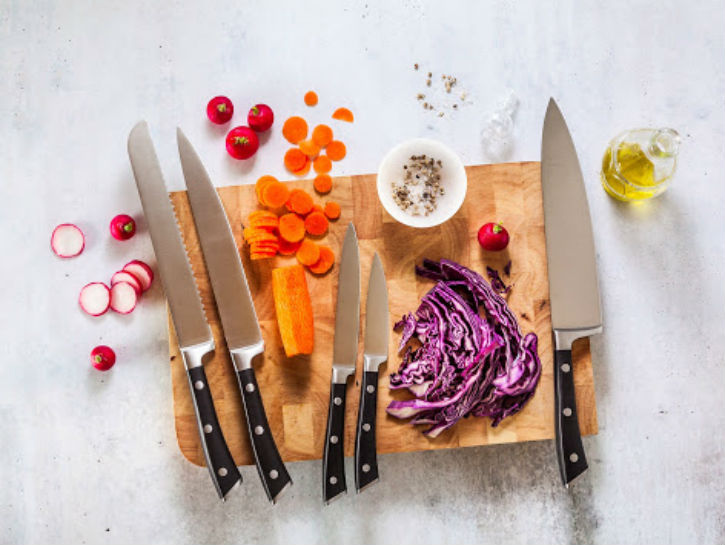We all have a lot of tools in our kitchen, and knives are definitely some of the most valuable things we have in our culinary arsenal. The right knives allow you to do everything from carving a chicken to finely dicing tomatoes. And, a good, quality knife can last a lifetime if you take care of it correctly.
But, it’s easy to make mistakes with your knives every step of the way – from purchasing to storage. And, if you don’t make the right decisions with your knives, it can drastically reduce their lifespan. Here are six common mistakes that many of us make with our kitchen knives.
1. Spending Too Much (Or Not Enough)

It can be difficult buying a good set of knives for your kitchen. They come in an incredibly wide range of prices, plus there are various types of knives made from different materials. This can make buying knives a challenge because you don’t know how much to spend.
It can be tempting to buy cheaper knives, but it is best to opt for knives that will last. And, for most home cooks, investing in a super-expensive set of professional quality knives isn’t necessary. According to The Kitchn, knives that last a long time and hold their edge should cost you about $50 to $100 each. If you pay too much or too little for your knives, it can be a big mistake.
2. Picking The Wrong Set

Once you know the proper price range for a good knife, the next thing to figure out is the type of knife you need. There are pros and cons to each type of metal used for making knives. For example, a high-carbon steel knife is a lot sharper than other metals, but it is also high-maintenance. So, you want to keep that in mind.
After you have determined the metal you want, you also need to take the size of the blade and handle into consideration. If you cut a lot of meat, you should consider investing in a knife with a longer blade. And, if you have small hands, you should look for something that has a handle that fits comfortably.
For most home cooks, all you will need are four basic knives to do your cutting jobs:
- chef’s knife
- paring knife
- serrated knife
- boning knife.
Also, don’t forget the honing steel!
3. Leaving Knives In the Sink

Obviously, it can be dangerous to leave knives in the sink, but not just for the next person who is doing dishes. When you leave a knife in the sink, it can get scratched, bent, or even broken. All it takes to cause some damage is dropping a heavy pan onto a knife. So, it is best to wash knives immediately after you use them. But, if you have to wait to wash them, place them on your countertop, so you don’t forget about them.
4. Washing Knives Improperly

Speaking of washing knives, you can also cause damage if you put them in the dishwasher. Other utensils can scratch your knives during the wash cycle, the chemicals in the detergent can cause discoloration and pitting, and the high-heat in the drying cycle can cause your knives to warp.
So, when you do have the time to wash your knives, do it by hand with hot water, gentle dish soap, and a soft sponge. Also, immediately dry your knives with a clean towel after washing because any moisture left on the blade or handle can cause mold or rust.
5. Not Storing Knives Correctly

You should always give your knives special consideration when it comes to storage. Always take the time to store your knives properly because they will keep their edge longer and will always be easily accessible when you need them.
If the only place you have in your kitchen for knife storage is a drawer, it is smart to invest in some in-drawer storage instead of storing the knives loosely. This will keep the blades from ricocheting off each other when you open the drawer, plus you won’t have to hunt for the right one.
Knife blocks are also a great option. But, if you do use a block, be sure to press the blunt edge against the slot when you remove it. If the sharp edge hits the slot, it will make it more difficult to keep the blade in good shape.
Another great option is a magnetic strip mounted to the wall. It will keep your knives off the counter, out of the drawers, and easy to find.
6. Cutting Incorrectly

When you are cutting food, pay attention to the volume of the chop sound. If it is too loud, chances are your knife isn’t sharp enough. You also want to use a rocking motion when you cut and keep the knife in contact with the cutting board as much as you can.
Also, use the back of the blade to gather up your slices and dices. And, when holding your knife for chopping, avoid extending a finger to push down on the back of the blade. This does not give you more control over the knife, and it will shift how you are applying pressure and guiding the blade.
And, when it comes to your other hand, always remember to tuck your fingers under your knuckles to avoid cuts.
